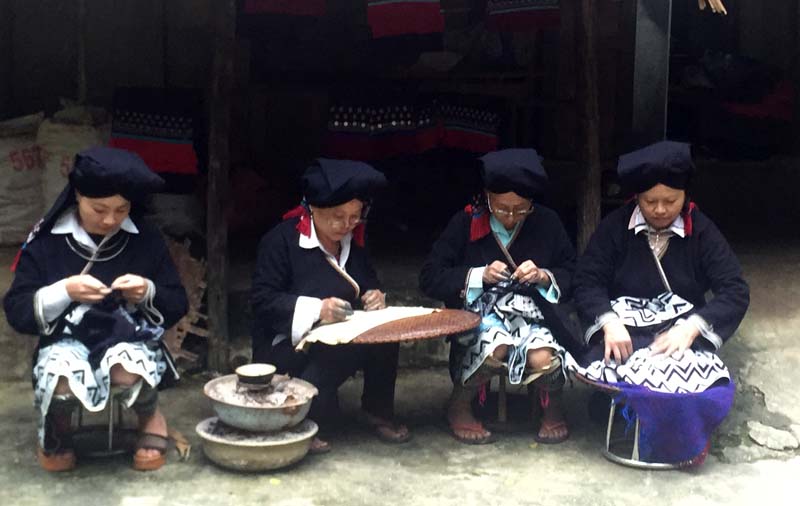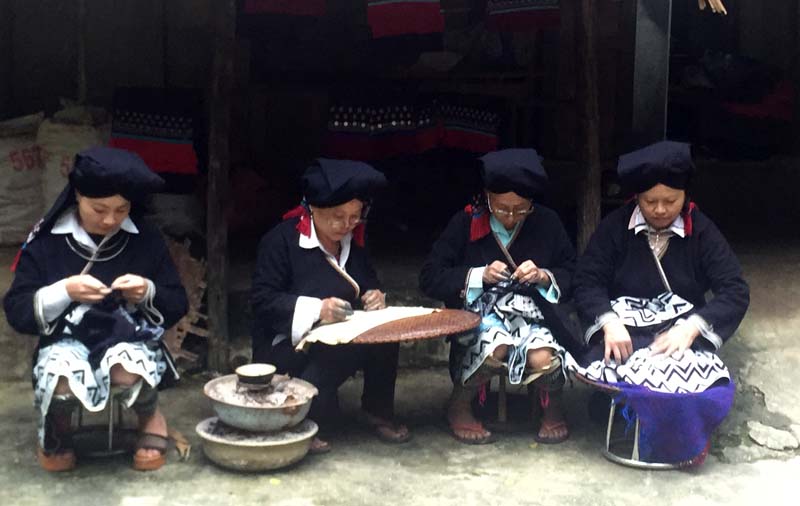


 Dao Tien ethnic women in Sung hamlet, Cao Son commune (Da
Bac) are skillfully embroidering the patterns and motifs to make the
traditional products.
Dao Tien ethnic women in Sung hamlet, Cao Son commune (Da
Bac) are skillfully embroidering the patterns and motifs to make the
traditional products.
Ms. Ly Thi Hai in Sung village says: Fabric is dyed indigo, which is quite complicated with many stages. First, the indigo trees are planted in the upland fields and are harvested on May, June and July of the lunar calendar. The indigo trees are cut to soak in water, the residues are picked up, putting into the lime to dissolve, through the deposition process the indigo core is collected then. When using, they will mix the ash filtered water with the indigo core to have the dyed fabric indigo water. The cloth is soaked in the indigo water for about 20 minutes and then is picked out to squeeze and dry under the sun. This process is repeated many times until the color is satisfied and it usually takes 20-30 days to get it a beautiful colored cloth.
For the costumes of Dao Tien ethnic people, the decoration patterns on the fabric are printed with beeswax, which is quite unique and sophisticated. Usually the fabrics with beeswax prints must be finished before dyeing indigo. To have good beeswax, people often use wild bees and Apis dorsata. In summer and autumn, the local people go to the forest to take beeswax and bring to heat for the wax.
When drawing, beeswax is put into a bowl or a small plate putting on a charcoal stove and they use a thin bamboo tool bended into a small frame, a small round bamboo tube and a copper bowl dotted with beeswax to print motifs on the cloth. The pattern printing on the fabric requires the details, carefulness of each stroke so that printed lines are beautiful, and they are not bent and skewed.
According to the ancient customs, Dao Tien daughters must know how to embroider and sew to get her own wedding dress before the marriage. From an early age, they wear the traditional costumes and when they are 10 years old, they are taught how to embroider from the simple to complicated stages by their mothers. At present, that tradition is still maintained in Sung hamlet and girls at the age of 10 have started to get used to embroidery of patterns, textures on fabrics and other stages to create the finished products. After being dyed and embroidered completely, the cloth can be used to make clothes, the interior decorations or cute bags.
At present, Sung hamlet, Cao Son commune has become a popular tourism community, especially for international tourists visiting and experiencing. Therefore, the brocade embroidery and painting of Dao Tien ethnic people is not only for making costumes and products for the living needs, but also for making souvenirs so that visitors can directly involve in the stages from indigo dyeing, wax painting to embroidery and purchasing scarves, costumes, bags ... as souvenirs. Thereby, it not only creates more income for the local people but also contributes to preserving and introducing the nation's unique culture to the domestic and international tourists.